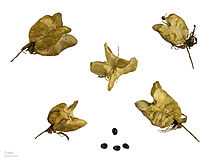Melianthus major
| Melianthus major | |
|---|---|
| | |
| Scientific classification | |
| Kingdom: | Plantae |
| (unranked): | Angiosperms |
| (unranked): | Eudicots |
| (unranked): | Rosids |
| Order: | Geraniales |
| Family: | Melianthaceae |
| Genus: | Melianthus |
| Species: | M. major |
| Binomial name | |
| Melianthus major L. | |

Melianthus major (giant honey flower or Kruidjie-roer-my-nie) is a species of flowering plant in the family Melianthaceae. It is an evergreen suckering shrub, endemic to South Africa and naturalised in India, Australia and New Zealand.[1][2] It grows to 2–3 m (7–10 ft) tall by 1–3 m (3–10 ft) wide, with pinnate blue-green leaves 30–50 cm (12–20 in) long, which have a distinctive odour. Dark red, nectar-laden flower spikes, 30–80 cm (12–31 in) in length, appear in spring, followed by green pods.[1][3] All parts of the plants are poisonous.[2]
The Latin binomial Melianthus major literally means "large honey flower".[4]
In cultivation this plant requires a sheltered location and may also need a protective winter mulch in temperate regions. It has gained the Royal Horticultural Society's Award of Garden Merit.[5]
References
- ↑ 1.0 1.1 "Melianthus major". PlantZAfrica.com. South African National Biodiversity Institute. Retrieved 2009-03-24.
- ↑ 2.0 2.1 Blood, Kate. (2001). Environmental weeds: a field guide for SE Australia. Melbourne, Australia: Bloomings Books. ISBN 0957908601.
- ↑ RHS A-Z encyclopedia of garden plants. United Kingdom: Dorling Kindersley. 2008. p. 1136. ISBN 1405332964.
- ↑ Coombes, Allen J. (2012). The A to Z of plant names. USA: Timber Press. p. 312. ISBN 9781604691962.
- ↑ "RHS Plant Selector - Melianthus major". Retrieved 24 May 2013.
| Wikimedia Commons has media related to Melianthus major. |